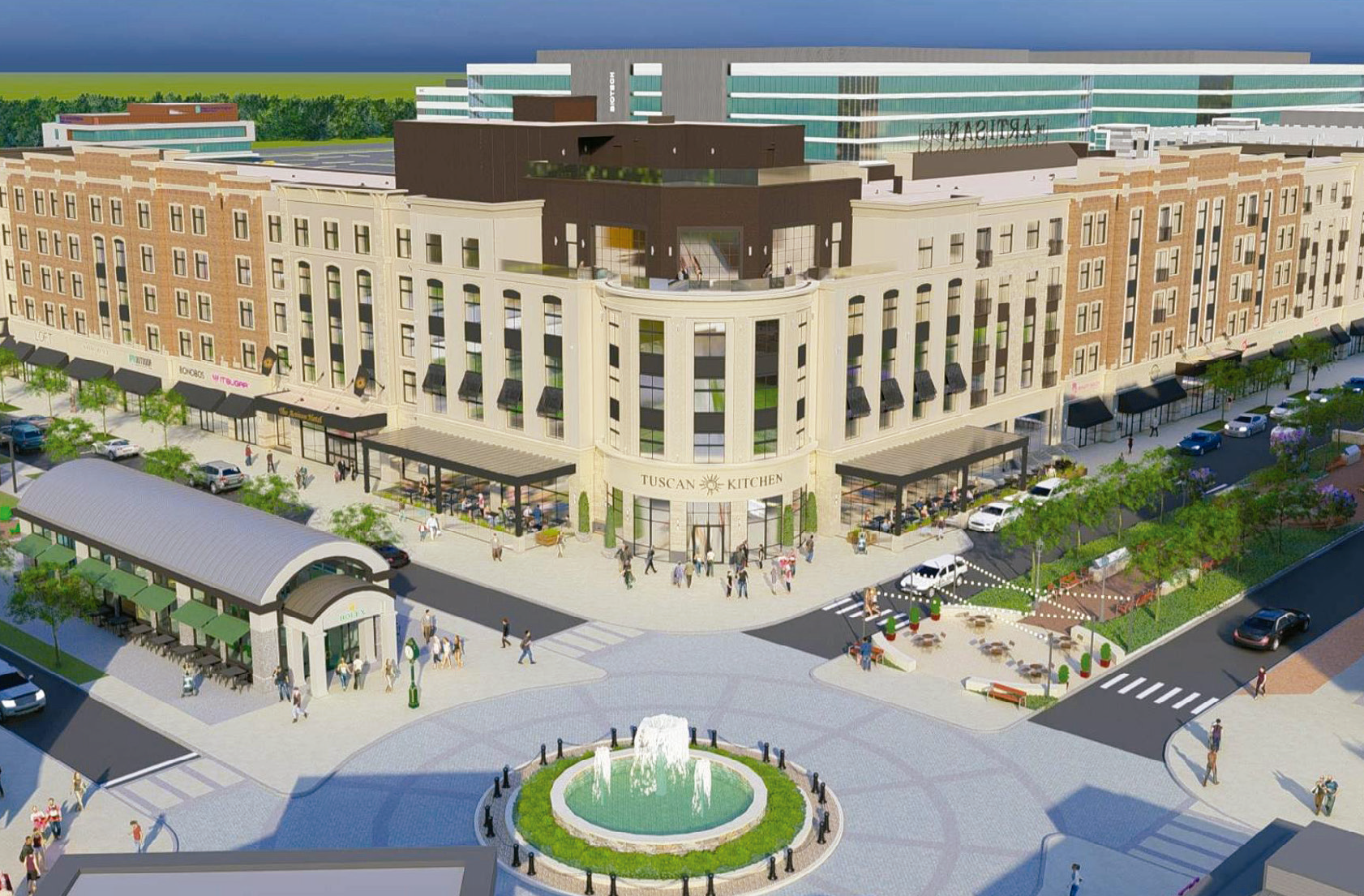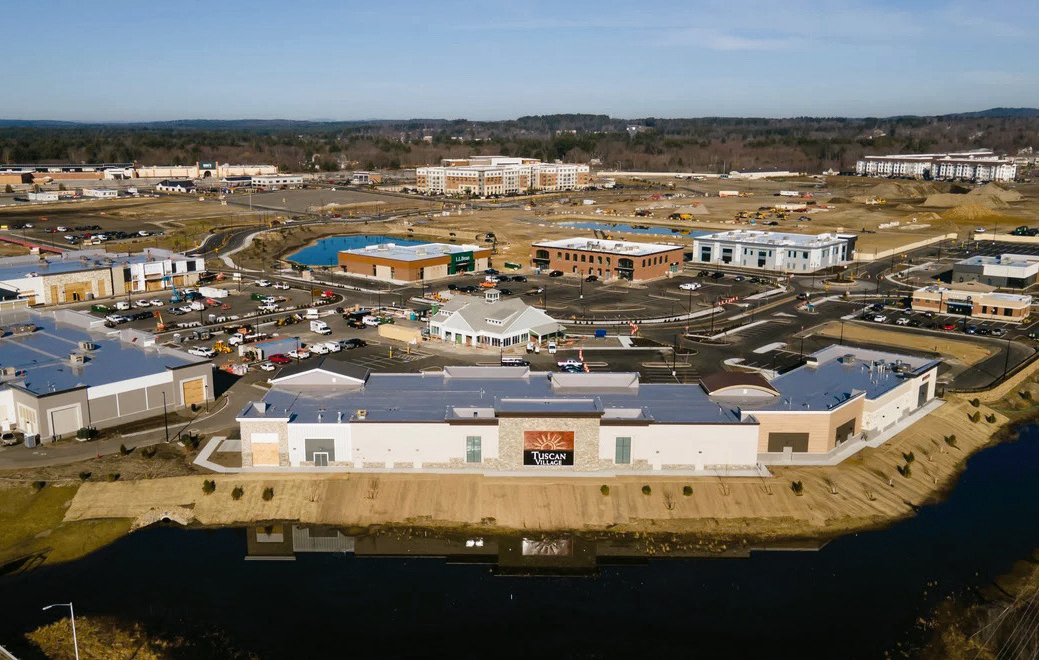The ‘lifestyle destination’ that once was ‘The Rock’
Tuscan Brands owner and developer Joe Faro’s final vision is a 4 million-squarefoot mixed-use “lifestyle destination.” (Photo by Allegra Boverman)
It’s a good bet that there aren’t two more disparate groups on the planet than cigar-chomping hardcore horseplayers and designer-brand shoppers. As humorist Dave Barry wrote: “Fashion at the racetrack is matching ink stains.”
The only reason someone dressed to the nines and laden with brightly colored shopping bags ever had to hobble over to the now-demolished Rockingham Park’s grandstand would be to ask the actual horse I Lost My Choo if his groom was hiding the missing Jimmy Choo $330 single suede heel. Having one half of the daily double ain’t worth nothin’ at the track.
The 170-acre lot the bedazzling but dense Tuscan Village is being built on, the former site of “The Rock,” is arguably the most expensive piece of real estate in New Hampshire. Off Exit 1 on Interstate 93, and with many of the planned 75-plus retail stores encompassing 700,000 square feet already open, Tuscan Village primarily beckons south with the call of “no sales tax.” (On a recent visit, the parking lots were easily 80 percent Massachusetts plates.)
Tuscan Brands owner and developer Joe Faro’s final vision is a 4 million-squarefoot mixed-use “lifestyle destination.” Faro is working with Salem’s OMJ Realty and Hooksett design and construction firm Procon on meeting his goal.
“The biggest challenges have been material price escalations and labor shortages, things that everyone is facing in the construction industry now,” Procon Managing Director John Stebbins said.
‘Lost opportunity’
Rockingham Park’s Golden Age was in the years 1933 to 1969 under the direction of Lou Smith.
Smith could hobnob with Cardinal Cushing, schmooze with a succession of New Hampshire governors, entertain Louis B. Mayer, and always draw the region together with causes. A mound of aluminum decorated the infield at one point during World War II – bring a patriotic pot to be turned into military hardware and get a free admission. Smith made it feel like going to the races was a charitable experience. Catholic Charities, Shriner’s Hospital, The Jimmy Fund and the Red Cross were just the start of the list of charities Smith and the old Rock supported.
Yes, Smith was public with charitable donations to keep politicians in Concord happy, but the Lou and Lutza Smith Charitable Foundation, set up by Lou before his death in 1969, distributed $4 million upon Lutza’s death in 1984.
Hall of Fame horses, jockeys and trainers spanned both the old and the new Rockingham Park. Champion horses included Seabiscuit, Dr. Fager and Peter Fuller’s Mom’s Command, with daughter Abby riding, in a partnership right out of National Velvet.
“For four years in the 1960s, 1964 to 1967, the richest three-year-old race in the country was the New Hampshire Sweepstakes,” Bill Nader, for many years the publicity director at Rockingham Park, said. “It offered more purse money than the Kentucky Derby or the other coveted Triple Crown races. It was a collaborative effort between Rockingham Park and the New Hampshire State Lottery.”
As with the Irish Sweepstakes, a grand lottery prize to one lucky individual was pegged to the winning horse in the New Hampshire Sweeps.

A six-story multi-use building (above) being constructed by Hooksett-based Procon at Tuscan Village will include a Marriott Hotel, retail, dining and residences. (Courtesy photo)

The 1980 fire that shuttered the Rock for four years was the dividing line between the old Rock and the new Rock. It was apparent from the moment the new Rock opened that a casino was in mind. Delaware North, among other developers, angled with state politicians, to no avail.
The last thoroughbred race was run in 2002, but thoroughbred racing at the new Rock had been dying a slow death since at least 1995. Top barns left. Top jockeys and horses went elsewhere. The kiss of death to harness racing, which ended in 2009, was the state’s refusal to pay for post-race drug testing.
The message was clear. A casino, or what is now called a racino, where racing is partially supported by an on-site casino, wasn’t going to happen.
“Yes, it was a lost opportunity that an agreement was not reached which would have preserved and enhanced racing history and channeled gaming demand responsibly,” Nader, who is now the director of racing, marketing and sponsorship for the prestigious Hong Kong Jockey Club, said. “We were trailblazers in the ‘60s with the first lottery in the nation. Think about that for a moment. “
5,000 jobs
Tuscan Brands owner/developer Joe Faro is wagering the 170 acres of Tuscan Village on mid to highend retail and dining, 1,200 luxury condominiums and apartments, medical buildings, a 400-seat movie theater, entertainment facilities and a 165-room Marriott Hotel. It’s a full race card.
Hanover Tuscan Village apartments are representative of the approximately 1,200 housing units. The open-concept spacious interiors are stunningly designed by Kathy Andrews Interiors of Houston. The 281-unit luxury building has sublime artwork in each residence, a gym, and an e-business room, among other amenities. You could entertain the Roman senate in the apartments’ walk-in baths.
Living at Tuscan Village is not for the light of wallet, however. Condominiums start at $649,000. A one-bedroom 1,213-square-foot apartment at Hanover Tuscan Village is $2,700 per month, utilities not included. A three-bedroom, 1,282-square-foot living space is $3,600. To be clear, Hanover is a separate company from Tuscan Brands. The building, which is 92 percent occupied, is the ideal location for the tech professionals who work along Massachusetts Route 128.
Like Lou Smith, Joe Faro is a very generous man. Tuscan Brands donated to 10,000 children this past holiday season through the Boys & Girls Clubs of Salem, Lawrence and Boston. He gave several million dollars just to his factory employees when he sold Joseph’s Gourmet Pastas and Sauces to Nestle in 2006.
And like Smith, Faro has cultivated a relationship beneficial to both parties with the town of Salem.
When completed, Tuscan Village will create approximately 5,000 jobs. The master plan for the development calls for 10 percent of the project’s housing plan to include workforce housing.
Postcard of the old Rockingham Park
“Joe Faro has partnered with a New Hampshire developer to provide a 73- unit workforce housing project on a site he owns on Main Street,” Salem Planning Board Director Ross Moldoff said. “The planning board has been very supportive of his plans.”
The Main Street apartments will range from $1,100 to $1,400.
“I will say that everything we’ve said we’re going to do, we’ve done,” Faro told the Salem Planning Board at a December meeting.
“As you know, it’s not something (workforce housing) we’re experienced with,” Faro said at the same meeting. “It’s not our first choice. We did it. It’s not necessarily the highest and best use for that property, but we understand the issue and we pivoted. We did that. It makes sense for the town. It makes sense for the development.”
Phase III construction at Tuscan Village will include 15 homes at The Villas in North Tuscan Village. Phase II construction of 30 condominiums is underway. The 40 Phase I homes are sold out.
The whole development is still a work in progress. Five major projects were started in December alone.
“This is a very complex building with multiple construction types, varied uses and extremely difficult exterior details,” Stebbins said of the recently started sixstory mixed-use building that will house a Marriott Hotel, retail, residences and dining. “Procon is most proud of our ability to design and then execute these complexities in the field. As we both design and build, we’re able to pivot more effectively than other companies.”
The Salem Planning Board has asked Faro to “design a recreation area of sufficient size and character for the new residential projects.”
The lack of an athletic field, unless one is planned for the triangular recreation field, points out the lack of green space. Copses of trees, a fountain and flowers are planned and will add much to the character of Artisan Drive and Tuscan Boulevard, but it’s hard to picture picnickers, chess players or Frisbee tossers in the space. A covered bandstand would also add to an outdoor communal effect. Two walking trails are planned at Tuscan Village, with one half-mile trail looping around a flood plain and close to the recreation field. There is seasonal volleyball and ice skating.
The late Jill Jellison was annually among the top women riders in the country by races won
Online Reddit reviews, the soapbox for the common man, fall primarily into three categories for Tuscan Village: the abandoned racetrack was an eyesore, the shopping will be great, and there is too much traffic in and around Tuscan Village.
Close to half of the Tuscan Village acreage is given over to parking for approximately 5,300 cars, with 1,680 accommodated in a five-story garage.
In Rockingham Park’s heyday, buses and trains from Boston, Providence and Hartford dropped off happy passengers at the track’s main gate. They were thrilled to spend a day out of the city at a racetrack once called “The Saratoga of New England.”
Change happens. ”Spend” is the best word that links a day at the old Rockingham Park and the ponies with a day shopping at the new Tuscan Village. In a day at the races you try to keep your money. In a day shopping you try to lose it.